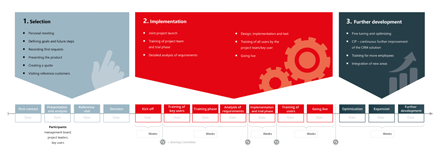06/10/21CRM implementation - How to make your digitalization project a success
More and more companies choose to implement a CRM solution to digitalize their processes and set the course towards a sustainably successful future.
 In order for this project to succeed, one factor is crucial for success in addition to the classic steps 'requirements, introduction and further development': people!To be more precise: the users who are supposed to work together using the CRM solution in your company. And, of course, the customers who are at the center of all company processes in the long run when using a CRM.
In order for this project to succeed, one factor is crucial for success in addition to the classic steps 'requirements, introduction and further development': people!To be more precise: the users who are supposed to work together using the CRM solution in your company. And, of course, the customers who are at the center of all company processes in the long run when using a CRM.
Methodological approach as guarantee for success
The introduction of new software often poses a challenge in any company. You need to keep an overview both of the scope of services, the costs, the increase in productivity, as well as the expenses of implementation and training, and the interplay between new and existing systems.
Our methodological approach, which has already been implemented in hundreds of customer projects, supports you in keeping this overview. The tried and tested CAS method is divided into three big phases: Selection, Implementation, and Further development. In turn, those phases are divided into smaller process steps. The systematical and structured approach establishes security and efficiency while including the people as a deciding factor for success in the process.
The most important steps in the process of successfully implementing a CRM solution
1. Phase 1 of your project starts with the Kick-Off Meeting. Together, you define the role of each individual member of the project team. Who is the CRM manager, project manager, key user, administrator, or project customer? Thus, you provide clarification on the roles and place responsibility in the hands of the participants. Clear rules for project communication establish trust and acceptance.
2. Cooperate to identify your requirements and focus on your goal. What do I need? What is important to me? And how can I best meet the requirements with a standard software? With this clarity concerning your own goals and requirements, you can familiarize yourself with your software provider and check for good chemistry. Mutual trust in the respective "sparring partner" and consultation at eye level are more important for cooperation than combing through feature lists.
3. The following step is to get to know the basic philosophy of the CRM software by participating in a training for the entire project team based on the standard product. During this training phase, the learned knowledge is applied by key users, and the processes of your daily business are reproduced to clear any upcoming questions. If required, you can get assistance via trainings by our implementing partners which are always available.
4. The subsequent recording of your requirements includes the analysis and discussion of processes. We recommend prioritizing the collected requirements as well as defining the essential basic requirements and quick wins after recording.
5. To bring phase 1 to an end, it is necessary to focus on the prioritized requirements and disregard further needs initially so that the first project success is quickly achieved. You can always implement further requirements at a later time.
6. A steering group releases the implementation and can decide any pending issues from the recorded requirements beforehand. The result is recorded in requirement documentation which includes a solution sketch - for example, a description of how to model a process in the software.
7. Considering the long-term use of the CRM solution and upcoming software updates, we recommend realizing the implementation as close as possible to the standard software version using customization options instead of commissioning custom-programmed features during phase 2. Ideally, you learn how to customize the solution yourself now. The implementing partner can work out a first draft with you.
8. The project team is actively involved in this phase, checks the process and configuration modeling for everyday suitability, and provides feedback.
9. Ideally, the users are trained by the key users (train the trainer concept). The partner trains the key users, who then train the users.
10. Going live ends the project implementation phase. Now, it is time for a short break and time to celebrate the implementation successes. Then, the project enters its next phase: "Further development and optimization". The third phase of a CRM project also includes the training of further employees and the integration of new departments.
Top 10 factors for a successful CRM implementation
Both the structured and methodological approach and the soft factors are essential variables for a successful CRM implementation. Therefore, you need to keep in mind the following besides the project method:
1. The first step - just go!
Define your big goals and divide them into smaller units and topics for a step-by-step approach. Ask yourself: where can I start? Where is my biggest pain right now? Which functions and processes provide the quickest benefits, what are the quick wins? Take heart and the first step. With good planning and good project management, you can overcome any obstacle. The great thing is: you celebrate the successes of the project participants together and thus motivate them for the next steps.
2. Create acceptance - common rules lead to the goal
Strengthen the process of change in your company by establishing clear goals and predefined rules. Thus, you can quickly dispel any possible fears and replace them with acceptance, security, and trust. The project participants are actively involved in the changes from the start. They experience a challenge that is fun. A tip for maximum commitment: create role cards with 'contract character', which illustrate the significance and responsibility of each project participant for the team.
3. CRM is a management issue
Management needs to back your CRM project, appoint the project team, and assign them the necessary rights and competencies. If you continuously communicate the importance and successes of the project to the company, the project team is bolstered up and on the path to success.
4. Customer Centricity as a comprehensive CRM strategy
The basis for the successful implementation of a CRM solution is a comprehensive CRM/XRM strategy: the Customer Centricity company strategy represents a future-oriented company culture that puts the customer at the center of all touchpoints, services, and product developments. It permeates the entire company and results in customer-centric business processes. Therefore, you need to check your orientation even before the project starts. Review the Customer Experience in your company and define a common 'where do we want to go'. Thus, your project is healthy and promising a successful future from the start.
5. Free expert insights - utilizing employee knowledge
The introduction of new technologies becomes more successful the more the user-specific perspective is taken into account. Your own employees are often the best consultants and process experts. This expertise is worth its weight in gold - so utilize it. At the same time, you create motivation and joy by making each employee part of the project success. You define the roles of key users, CRM managers, or administrators in the project team. Then, during a kind of 'practice phase', the team members themselves define and model the respective processes while immediately resolving any arising questions. Subsequently, the key users contribute their specific requirements, for example, from the marketing, sales, and service departments. The developed processes are recorded in process guides which are then available to all employees.
6. A must: the system and process check
Before implementing, the first step is to record and check the technical and commercial conditions of your existing IT and communication structures. Processes are scrutinized and the communication within the organisation is tested. To successfully implement a CRM software, you need to focus on your customers via all contact channels. Versatile ERP, CPQ, or ECM solution integrations are included in the information flow in the course of the project. You enable your employees to design an ideal and seamless Customer Journey and save them the time they can better spend on customers.
7. Your competitive advantage - total focus on core processes
Nowadays, processes and requirements are dynamically changing, which is why it makes sense to quickly achieve 80 % of your goal instead of 100 % in twice the time. If your CRM project takes too long, the excitement for the new solution is lost, and circumstances or processes can change in the meantime. It's not a matter of digitalizing all business processes overnight, but rather conducting a meaningful analysis and driving forward the digital transformation step-by-step. Put on your customer's glasses regularly and take a look at the Customer Experience to discover any potential for optimization in your processes. Because although digital technologies make our work easier and more efficient, business is always done between people.
8. Partner at eye level - bet on future and investment security
When choosing a software provider, you look out for a CRM system that can keep up with your company progress. A company developing flexible CRM/software solutions that is established on the market provides you with high security of investment and, thus, the option to find the custom-fit system to support all company phases. It is beneficial to choose a software provider who knows the business and communication processes of a small- or medium-sized company well. Plus: A deeper understanding of customer processes ensures cooperation based on partnership and high standards as well as the secure implementation of the project. Last, the chemistry between company and implementing partner must be right to successfully get a CRM project off the ground.
9. In exchange - maintaining open communication anytime
People don't always agree - different opinions are part of the process and support the positive development of a project. If there's friction in your teams, you need to quickly address the possible conflicts and foster open communication. The predefined rules help you to quickly identify and resolve any potential for conflict. For if you have outlined a plan together from the start, for example, using the rules, you will be able to resolve any conflicts more quickly when things don't go as planned. Thus, your CRM project stays on track, and your team works well and efficiently together in the long term.
10. After the game is before the game - keeping the objective perspective
The step-by-step approach is the key for a successful software implementation. Usually, the successful implementation of your CRM project starts a long-term partnership. New requirements arise, customizations and other company departments are included. However, even the standard software is always updated - there are new versions with new functions and modules. CRM is a philosophy that lives from the new ideas of all employees. That is why the project team should remain unchanged and continue to meet. Thereby, they can become the central contact for processes and requirements of your employees and the company. Steering committees, yearly evaluations, or review appointments after the first installation are also good options to check whether you are still on the right path and the system is running smoothly.

Contact the CAS CRM expert Martin Kestner by e-mail or phone (+49 721 9638-188) and get even more expert knowledge.
Picture: Martin Kestner, Head of Projects XRM solutions
Out of the box tips for project implementation and development
- Starting easy - define your goals and start step-by-step towards the goal
- Applying promising methods - customized to fit your company
- Keeping it close to the standard - utilize all configuration options of the product
- Clearly defining and positioning roles - keep the project team for further development
- Maintaining cooperation - with the software provider, partner, and the project team
- Continuing on - ask yourself after implementation: do the team and functions still fit?
- Don't forget: after the project is before the project - Customer Centricity permanently remains the correct company philosophy



